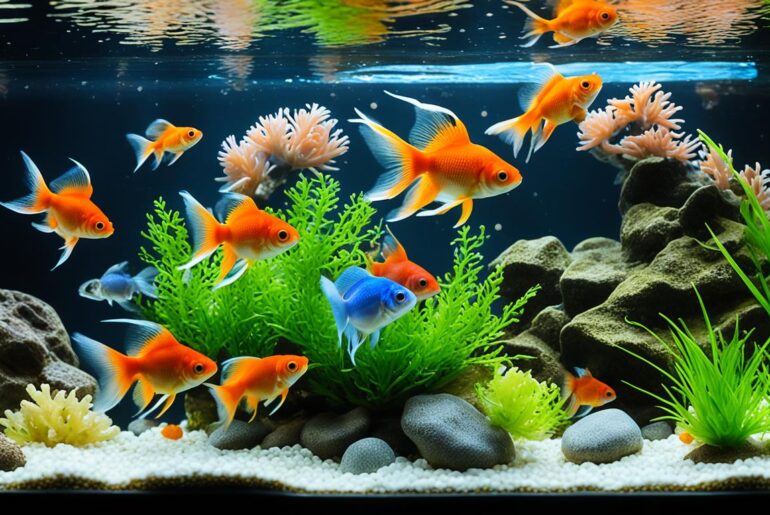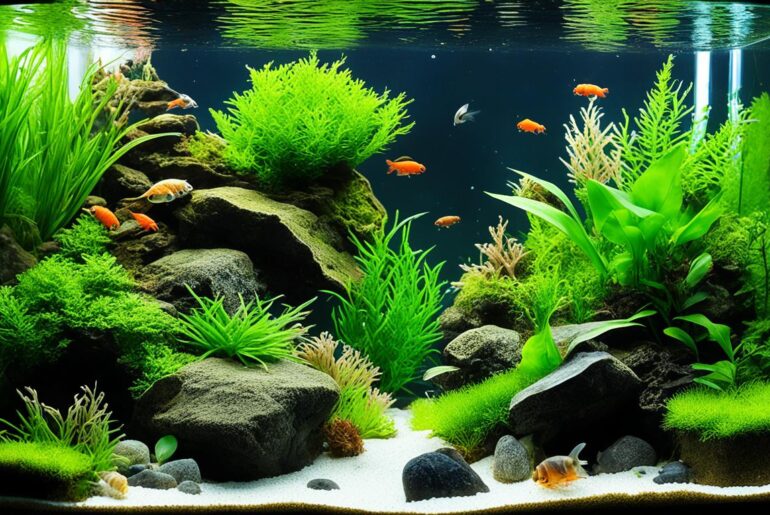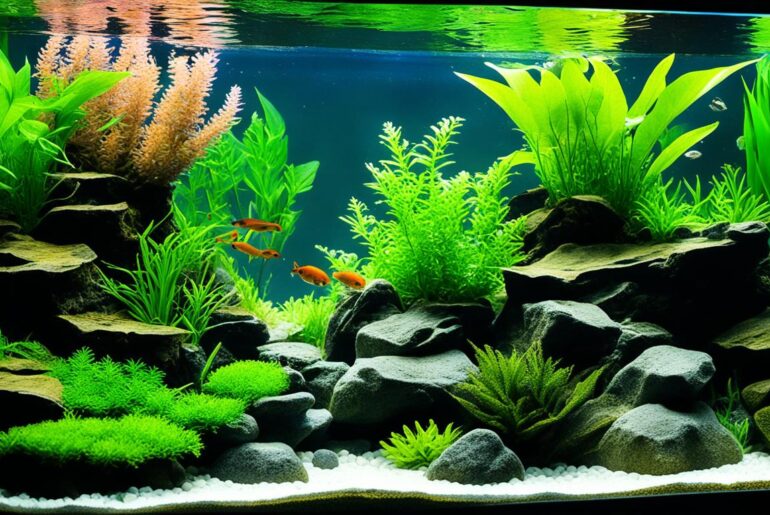Have you ever wondered what those tiny creatures are in your freshwater aquarium? Are they harmful or beneficial to your tank’s ecosystem? And most importantly, how can you identify and understand them better?
Snails are a common occurrence in freshwater aquariums, often hitching a ride on live plants. They can reproduce rapidly and overpopulate the tank. However, not all snails are harmful. In fact, many are beneficial as they help to maintain the balance of the aquarium ecosystem by eating decaying matter and algae.
In this guide, I will take you through the fascinating world of common snail species found in freshwater aquariums. Together, we will explore their characteristics, behaviors, and ways to identify them. So, let’s dive in and become snail experts!
Key Takeaways:
- Snails are a natural part of freshwater aquariums and can provide both benefits and challenges.
- Not all snails are harmful; many species play a vital role in maintaining the aquarium ecosystem.
- Identifying common snail species is crucial for understanding their behaviors and managing their populations.
- Snails can enter your aquarium through live plants, objects added to the tank, or transferring from one tank to another.
- Proper identification and management of snail populations can help maintain a healthy and balanced aquarium environment.
How Do Snails Enter Your Aquarium?
Snails can find their way into your aquarium through various means. One common method is through live plants that you introduce to your tank. These plants may carry snail eggs or even live snails, which can survive in sealed bags and are released once the plants are placed in the tank. The eggs can hatch, resulting in a snail population in your aquarium.
“Snails can also hitch a ride on objects that you add to the tank, such as substrate, filters, or decorations.”
If these objects come from a tank that already has snails, it is likely that snails or their eggs will be transferred to your tank as well. Snails are excellent hitchhikers and can easily attach themselves to these objects, finding their way into your aquarium unnoticed.
Snail Eggs on Live Plants
Live plants are a common source of snails in aquariums. When you purchase live plants from stores or fellow hobbyists, it’s important to inspect them for any signs of snails or their eggs. These eggs are often transparent and can be difficult to spot, but they may appear as small gel-like blobs attached to the leaves or stems of the plants. It’s crucial to thoroughly rinse and dip the plants in a snail-killing solution to ensure that any potential snails or eggs are eliminated before adding the plants to your aquarium.
Snails Hitchhiking on Objects
Aside from live plants, objects that you add to your tank can also harbor snails. Substrate, filters, decorations, and even the water itself can contain snails or their eggs. When introducing new items to your aquarium, it’s important to inspect them carefully and rinse them thoroughly. This will help minimize the risk of inadvertently transferring snails into your tank.
Transferring Snails from One Tank to Another
Transferring objects or even water from one tank to another can lead to the transfer of snails as well. If you are moving or setting up a new tank using water or objects from an existing tank that has snails, you are likely to introduce snails into the new tank. It’s essential to be vigilant and take appropriate measures to prevent the spread of snails.
To summarize, snails can enter your aquarium through live plants, hitch a ride on objects, or be transferred from one tank to another. It’s crucial to be cautious when introducing new items and ensure that snails or their eggs are not inadvertently brought into your tank. Taking proactive measures can help you maintain better control over the snail population in your aquarium.
Identifying Pest Snails
When it comes to freshwater aquariums, not all snails are welcome guests. There are certain species that can quickly become pests and pose a threat to the balance of your tank. It’s important to be able to identify these pest snails so that you can take the necessary steps to manage their population.
Bladder Snails (Physella acuta)
Bladder snails are small, teardrop-shaped snails that have gray shells with yellow spots. They are often introduced to aquariums as hitchhikers on live plants. These snails are prolific breeders and can quickly populate your tank if left unchecked.
Ramshorn Snails (Planorbella duryi)
Ramshorn snails are named for their distinctive round shells with a spiral shape, resembling a ram’s horn. They come in various colors including red, pink, and blue, making them an attractive addition to some aquariums. However, their rapid reproduction can lead to overpopulation, especially in tanks with an abundance of food and decaying matter.
Malaysian Trumpet Snails (Melanoides tuberculata)
Malaysian trumpet snails are easily recognized by their cone-shaped shells. They are known for their burrowing behavior and can often be found in the substrate of the aquarium. These snails play a beneficial role in aerating the substrate and consuming decaying organic matter. However, they can also reproduce rapidly and become pests if their population is not controlled.
By familiarizing yourself with the physical characteristics of these pest snails, you can quickly identify if they are present in your aquarium. Early detection is key when it comes to managing their population and preventing infestations.
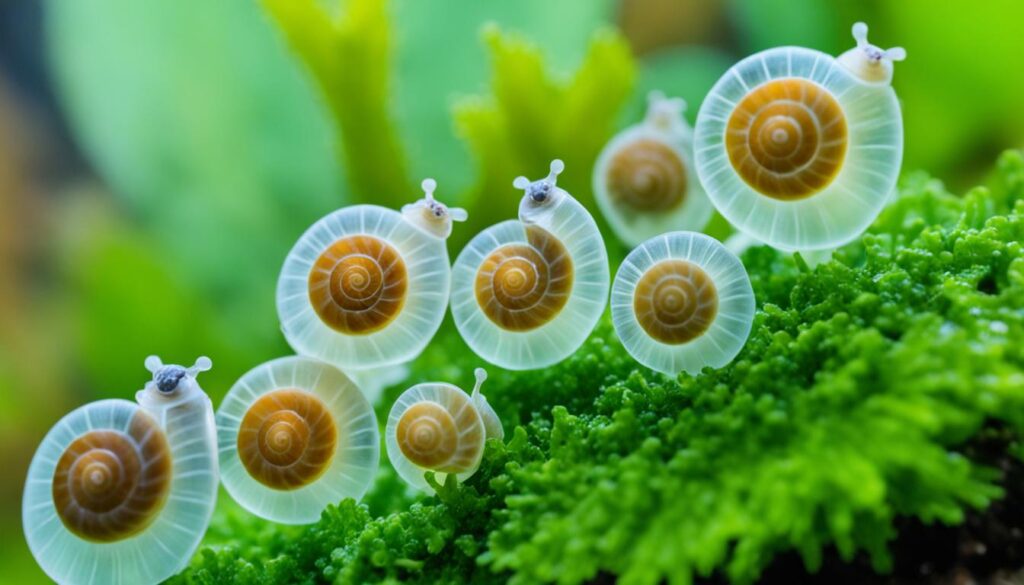
| Pest Snail Species | Physical Characteristics |
|---|---|
| Bladder Snails | – Teardrop-shaped shells – Gray coloration with yellow spots |
| Ramshorn Snails | – Round shells with a spiral shape – Various colors including red, pink, and blue |
| Malaysian Trumpet Snails | – Cone-shaped shells – Burrow in the substrate |
Benefits of Snails in the Aquarium
Snails, often considered pests, can actually provide numerous benefits to your freshwater aquarium. They play a vital role as detritivores, helping to break down decaying matter in the tank. This includes fish waste, uneaten food, and dead plants. By consuming and decomposing these organic materials, snails prevent them from accumulating and polluting the aquarium water.
In addition to their detritivore function, snails also play a crucial role in controlling algae growth. Many species of snails are herbivores and have a voracious appetite for algae. They graze on the surfaces of the tank, including the glass, rocks, and even plants, consuming the algae and preventing it from overrunning the aquarium. This helps to maintain a clean and visually appealing environment.
“Snails provide valuable cleaning services in the aquarium, devouring decaying matter and keeping algae growth in check.”
Moreover, snails have the ability to access hard-to-reach areas of the tank that may be difficult for fish to reach. They can efficiently clean nooks, crannies, and corners, removing debris and maintaining overall cleanliness. This contributes to the overall health and well-being of the tank inhabitants.
Snails are beneficial in multiple ways, aiding in the maintenance and balance of your freshwater aquarium. They perform the essential role of detritivores, breaking down decaying matter, and acting as natural cleaners by consuming algae. By introducing snails into your tank, you can take advantage of their valuable services and enjoy a cleaner and healthier aquarium ecosystem.
Reproduction and Growth of Snails
Snails are fascinating creatures that have the remarkable ability to reproduce rapidly, leading to their overpopulation in aquariums. This section will delve into the various aspects of snail reproduction, including their rapid growth, hermaphroditic nature, and even asexual reproduction.
The Marvel of Snail Reproduction
Snails are prolific reproducers, laying eggs in large clutches that can contain dozens of individual eggs. This ensures a high chance of survival for at least some of the offspring, even in the presence of predators. The reproduction process starts early for some snail species, with individuals as young as 35 days of age capable of reproducing.
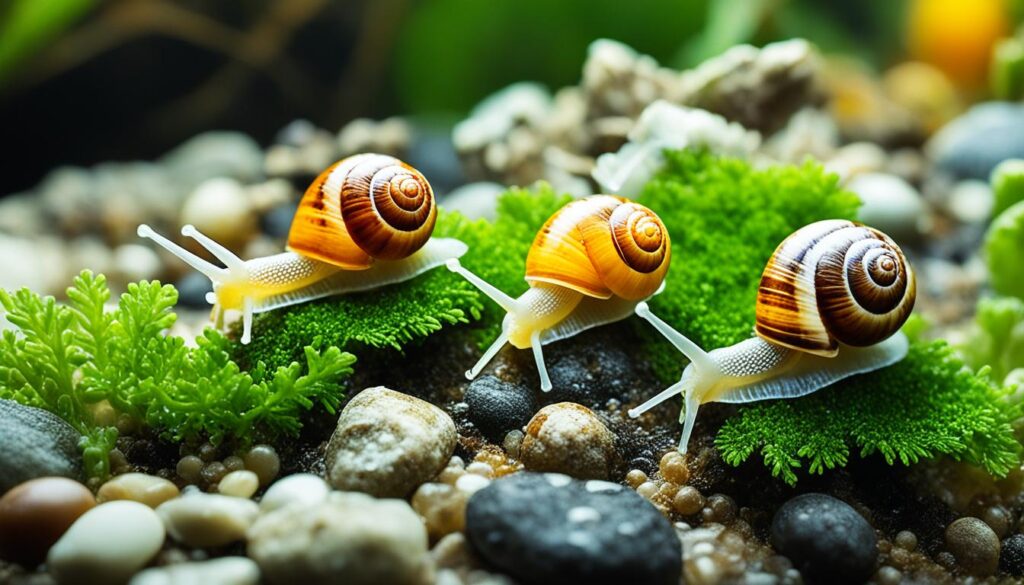
One of the most intriguing aspects of snail reproduction is their hermaphroditic nature. Many snails possess both male and female reproductive organs, allowing them to self-fertilize and lay fertile eggs even if there is only one individual present in the tank. This remarkable adaptation ensures that snails can continue their reproductive cycle without the need for a mate, leading to rapid population growth.
Asexual Reproduction: Nature’s Cloning
In addition to their hermaphroditic capabilities, some snail species can reproduce asexually. This means they can essentially clone themselves, resulting in offspring that are genetically identical to the parent snail. Asexual reproduction in snails involves the development of embryos without the need for fertilization, allowing for the rapid expansion of population sizes. This unique feature further contributes to the quick growth of snail populations in aquariums.
A Complete Table on Snail Reproduction
| Reproductive Aspect | Description |
|---|---|
| Rapid Reproduction | Snails lay large clutches of eggs, ensuring a high chance of survival for offspring. Some species can start reproducing as early as 35 days of age. |
| Hermaphroditism | Many snails possess both male and female reproductive organs, allowing them to self-fertilize and lay fertile eggs even without a mate present. |
| Asexual Reproduction | Some snail species can reproduce asexually, resulting in genetically identical offspring that contribute to the rapid expansion of population sizes. |
Understanding the unique reproductive abilities of snails is essential for effectively managing their populations in aquariums. With their rapid reproduction, hermaphroditism, and asexual reproduction, snails have developed remarkable strategies to thrive in various environments.
Harmful Effects of Snails on Plants
While having snails in your freshwater aquarium can provide certain benefits to the ecosystem, it’s important to be aware of the potential negative effects they can have on aquatic plants. Snails are often blamed for damaging plants and creating holes in their leaves, leading to concerns among aquarium enthusiasts. However, it’s worth noting that snails rarely target healthy plants for their feeding. Instead, they primarily feed on dying plant leaves that are decaying in the water.
This feeding behavior is especially prominent in emersed-grown plants that are transitioning from their above-water state to being fully submerged. Snails play a vital role in cleaning up dying plant matter and preventing it from accumulating in the aquarium as debris. By consuming decaying leaves, snails contribute to maintaining a healthier environment for your aquatic plants.
It’s important to emphasize that snails are not the primary cause of damage to healthy plants. Factors such as inadequate lighting, nutrient deficiencies, or imbalanced water conditions are usually the main culprits. Therefore, it’s crucial to address these issues rather than solely focusing on snail control as a solution to maintaining the health of your aquarium plants.
“Snails rarely go after healthy plants. Instead, they tend to feed on dying plant leaves that are decaying in the water.”
Understanding the feeding habits and behaviors of snails can help alleviate concerns and bring clarity to their role in your freshwater aquarium. Providing a well-balanced and nutritious environment for your plants, coupled with regular maintenance and monitoring, will contribute to the overall health and vitality of your aquarium ecosystem.

The Benefits of Snails in Maintaining a Clean Aquarium
- Snails assist in cleaning up dying plant matter and preventing debris buildup.
- They contribute to the natural balance of the aquarium by consuming decaying leaves.
- Snails aid in controlling algae growth by feeding on it.
- They access hard-to-reach areas where fish may not be able to clean effectively.
Managing Snail Populations
If you find that your aquarium has an overpopulation of snails or you simply do not want them in your tank, there are several methods you can use to manage their numbers.
- Limit their food sources: Avoid overfeeding your fish as it contributes to the growth of snails. Additionally, regularly cleaning the tank and removing decaying matter and algae can help reduce their food supply.
- Manual removal: Physically removing snails from the tank whenever you spot them is another effective method. You can use a net or tweezers to carefully remove them without harming other tank inhabitants.
- Chemical treatments: There are chemical treatments available in the market specifically designed to control snail populations. However, it’s important to use them carefully and according to instructions to avoid any harm to other tank inhabitants.
By implementing these methods, you can effectively reduce the snail population, control snails in your aquarium, and prevent snail infestation.

| Methods | Effectiveness | Potential Side Effects |
|---|---|---|
| Limiting food sources | Moderate | Reduces overpopulation but may not completely eliminate snails |
| Manual removal | High | Labor-intensive and may require repeated efforts |
| Chemical treatments | High | Possible harm to other tank inhabitants if not used properly |
“Managing snail populations in an aquarium requires a combination of methods to achieve the desired results. By being proactive and consistent in your approach, you can effectively control the number of snails and prevent infestation.” – Aquarium Enthusiast
Common Species of Snails
When it comes to freshwater aquariums, there are three common species of snails that can be found: bladder snails, Malaysian trumpet snails, and ramshorn snails. Each species has its own unique characteristics and behaviors.
Bladder Snails: Bladder snails have teardrop-shaped shells with gray coloration and yellow spots. They are omnivorous, meaning they eat both plant matter and small organisms. One key characteristic of bladder snails is their ability to reproduce quickly, making them one of the most common snail species in aquariums.
Malaysian Trumpet Snails: Malaysian trumpet snails have cone-shaped shells and are known for their burrowing behavior. They are also omnivorous and feed on algae, detritus, and leftover fish food. Their habit of burrowing in the substrate can help aerate it and improve overall water circulation.
Ramshorn Snails: Ramshorn snails have round shells with a distinctive spiral shape. They come in various colors, such as red, pink, and blue. Like the other two species, ramshorn snails are omnivorous and consume decaying matter, algae, and uneaten fish food. They can be beneficial in cleaning up the aquarium environment.
If you have any of these snail species in your aquarium, it’s important to understand their characteristics and behaviors to effectively manage their populations and maintain a healthy tank.
Comparison of Snail Species
| Snail Species | Shell Shape | Colors | Diet | Reproduction |
|---|---|---|---|---|
| Bladder Snails | Teardrop | Gray with yellow spots | Omnivorous | Rapid |
| Malaysian Trumpet Snails | Cone | Varies | Omnivorous | Live-bearing |
| Ramshorn Snails | Round with spiral | Various colors | Omnivorous | Eggs or live-bearing |
Understanding the physical features, eating habits, and reproductive abilities of these common snail species can help you identify and manage their populations effectively.
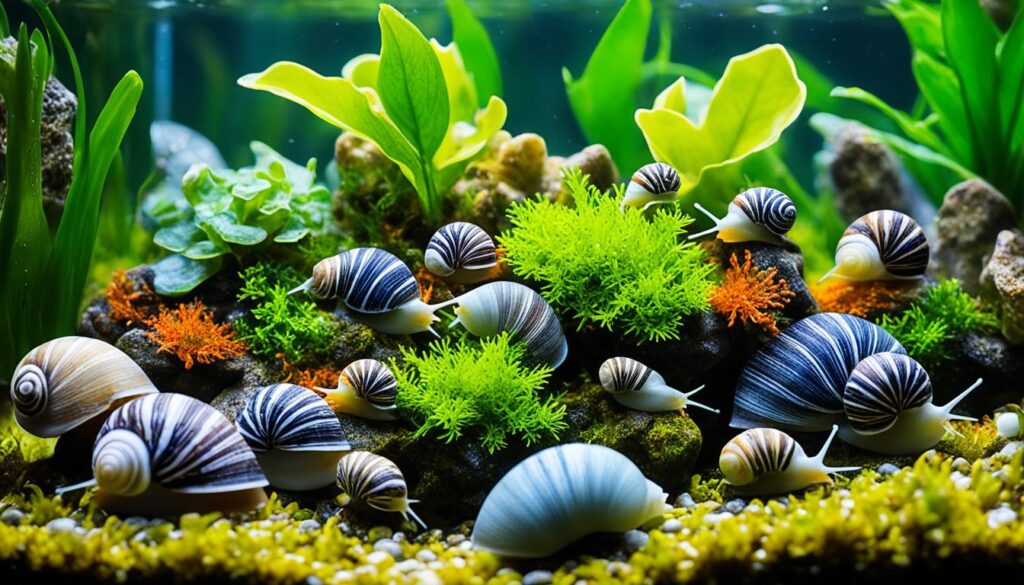
Pond Snails as Pest Snails
Pond snails are notorious pests in freshwater aquariums, causing harmful effects on aquarium plants and posing challenges for tank enthusiasts. These small mollusks are hermaphrodites, meaning they possess both male and female reproductive organs, allowing them to self-fertilize. This unique ability results in rapid and exponential population growth within a short period.
One of the most concerning aspects of pond snails is their voracious appetite for aquarium plants. They can munch on a wide range of plant species, causing significant damage to the foliage and affecting the overall aesthetic appeal of the tank. This makes them particularly troublesome for aquariums with planted setups, as maintaining a thriving underwater garden becomes a constant battle against these persistent pests.
The ability of pond snails to reproduce quickly exacerbates the problem further. Each pond snail can lay multiple egg clutches, each containing several dozen eggs. These eggs hatch into baby snails, rapidly contributing to the snail population explosion. The combination of their rapid reproduction and insatiable appetite for plants can quickly turn a peaceful aquarium into a snail-infested environment.

The harmful effects of pond snails on aquarium plants can be a frustrating experience for aquarium enthusiasts. Nevertheless, there are several methods to manage pond snail populations and regain control of your tank’s ecosystem.
“Pond snails are notorious pests in freshwater aquariums, causing harmful effects on aquarium plants and posing challenges for tank enthusiasts.”
Methods to Manage Pond Snail Populations
Controlling pond snail populations requires a multi-faceted approach to effectively reduce their numbers and prevent further infestation:
- Regular Monitoring: Careful observation of the tank will help detect early signs of pond snail presence, allowing for prompt action.
- Manual Removal: Whenever you spot pond snails, physically remove them from the tank. Be thorough and diligent in this process to minimize survival and reproductive chances.
- Improved Feeding Practices: Overfeeding can contribute to snail population growth as excess food serves as a readily available food source. Feeding the appropriate amount of food can help limit their reproductive capabilities.
- Aquatic Predators: Introducing snail-eating aquatic species such as pea puffers or certain loach species can assist in controlling the pond snail population. However, it is essential to consider the compatibility of these species with the existing tank inhabitants before making any introductions.
- Chemical Treatments: Chemical treatments specifically designed to eradicate snails can be utilized as a last resort. However, caution should be exercised when using these methods, as they can harm other tank inhabitants if not used according to instructions.
| Methods to Manage Pond Snail Populations | Pros | Cons |
|---|---|---|
| Regular Monitoring | – Allows for early detection and prompt action – Prevents further infestation |
– Requires frequent observation and attention – Does not eliminate existing snails |
| Manual Removal | – Direct and immediate control of snail population – Minimizes reproductive chances |
– Time-consuming and labor-intensive – May not completely eradicate snails |
| Improved Feeding Practices | – Limits snail reproductive capabilities – Reduces available food source |
– Requires careful monitoring of fish feeding – Snails may persist if other food sources are present |
| Aquatic Predators | – Natural eradication of snails – Adds diversity to the aquarium ecosystem |
– Compatibility issues with tank inhabitants – Predators may harm other desired components of the tank |
| Chemical Treatments | – Rapid reduction of snail population – Easy and effective control |
– Potential harm to other tank inhabitants – May disrupt the balance of the ecosystem if used improperly |
By implementing these methods and maintaining a diligent approach, you can regain control over your aquarium and minimize the harmful effects of pond snails on your beloved aquatic plants.
Ramshorn Snails as Pest Snails
Ramshorn snails are a common occurrence in freshwater aquariums and can be considered moderate pests. While they may not cause as much damage to plants as pond snails, they have the potential to reproduce rapidly and become overpopulated if not controlled.
Ramshorn snails are hermaphrodites, meaning they have both male and female reproductive organs. This allows them to breed with any other ramshorn snail in the tank, leading to exponential population growth. They primarily feed on algae and leftover fish food, but they can also consume decaying matter.
To control the population of ramshorn snails in your aquarium, it is important to implement proper feeding practices and regular maintenance. Avoid overfeeding your fish, as excess food can contribute to snail population growth. Remove any uneaten food promptly to prevent it from becoming a food source for the snails. Regularly clean the tank to remove decaying matter and debris, as this can also serve as a food source for ramshorn snails.
Control of Ramshorn Snail Population:
- Practice proper feeding habits and avoid overfeeding
- Remove excess food and decaying matter from the tank
- Regularly clean the tank and maintain good water quality
- Manually remove snails from the tank whenever you spot them
- Introduce natural predators, such as certain fish species or assassin snails
By following these practices, you can help to keep the population of ramshorn snails in check and maintain a healthy balance in your aquarium.
| Reasons for Ramshorn Snails Infestation | Control of Ramshorn Snail Population |
|---|---|
| Rapid reproduction due to hermaphroditic nature | Proper feeding practices |
| Feeding on algae and leftover fish food | Regular maintenance and cleaning |
| Consuming decaying matter | Manual removal of snails |
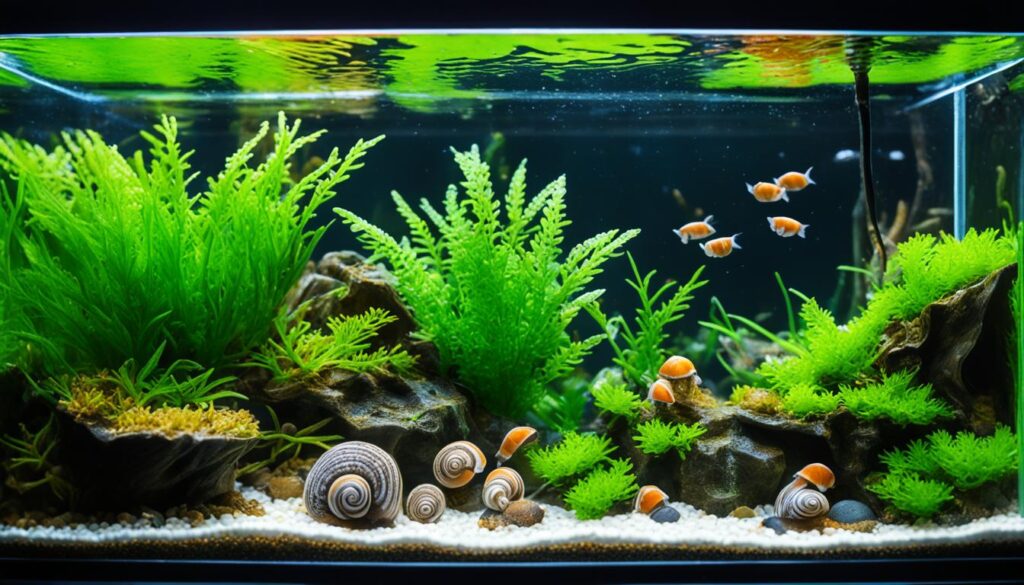
Malaysian Trumpet Snails as Pest Snails
In freshwater aquariums, Malaysian trumpet snails are often seen as beneficial creatures. They provide valuable services such as aerating the substrate and consuming decaying matter. However, if their population is not properly controlled, these snails can quickly become pests.
One distinctive behavior of Malaysian trumpet snails is their burrowing nature. They have a unique ability to dig into the substrate, making it challenging to remove them once they establish themselves in the tank. This behavior can result in an overabundance of snails, which can disrupt the balance of the aquarium ecosystem.
To prevent infestation by Malaysian trumpet snails, it is crucial to maintain a careful balance in the tank. This involves considering the number of snails in relation to other tank inhabitants. Additionally, implementing proper feeding and cleaning practices can help control their population.
Keeping their numbers in check is essential to prevent Malaysian trumpet snails from becoming pests that overwhelm the tank. By employing these preventive measures, aquarium enthusiasts can ensure a healthy and harmonious environment for all inhabitants.
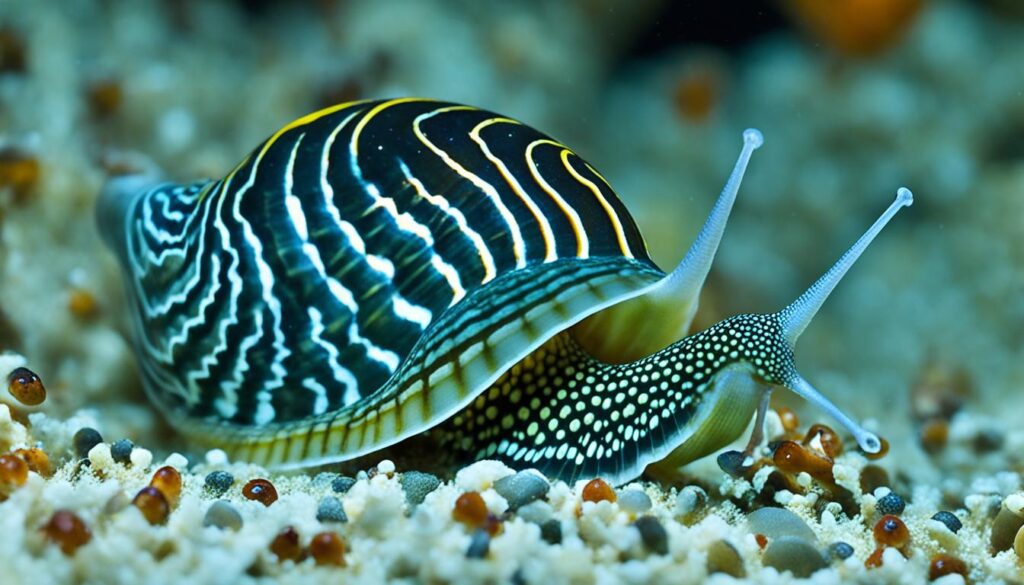
Conclusion
In conclusion, snails play a significant role in freshwater aquariums, both as beneficial contributors and potential pests. While some species, such as bladder snails, ramshorn snails, and Malaysian trumpet snails, can reproduce rapidly and cause damage to plants, others help to maintain a healthy ecosystem by consuming decaying matter and controlling algae growth.
Proper identification of snail species is crucial for understanding their characteristics and behaviors. By implementing effective management strategies and preventive measures, aquarium enthusiasts can strike a balance in their tank and create a harmonious environment for both fish and snails.
Managing snail populations can be achieved by limiting their food sources, practicing regular tank maintenance, and employing manual removal techniques if necessary. It is also important to be cautious when introducing new items to the aquarium to prevent unintentional snail infestations.
In summary, a comprehensive understanding of snail identification and the appropriate measures for managing their populations are essential for maintaining a thriving freshwater aquarium. By staying vigilant and proactive, aquarists can enjoy the benefits of snails while minimizing the potential challenges they may pose.
FAQ
How do snails enter your aquarium?
Snails can enter your aquarium through live plants, hitchhiking on objects added to the tank, or transferred from another tank.
How can you identify pest snails in your aquarium?
Pest snails in aquariums include bladder snails, ramshorn snails, and Malaysian trumpet snails. They can be identified based on their physical characteristics.
What are the benefits of having snails in your aquarium?
Snails in aquariums help to break down decaying matter, control algae growth, and clean hard-to-reach areas of the tank.
How do snails reproduce and grow in aquariums?
Snails reproduce rapidly, with many species laying eggs and some even reproducing asexually. They can quickly overpopulate an aquarium.
Do snails harm aquatic plants in the aquarium?
Snails generally do not eat healthy plants but rather feed on decaying plant matter. They can help to clean dying plant leaves and prevent debris in the tank.
How can you manage the population of snails in your aquarium?
You can manage snail populations by limiting their food sources through proper feeding practices, manual removal, or the use of chemical treatments.
What are the most common species of snails found in freshwater aquariums?
The most common species of snails in freshwater aquariums are bladder snails, Malaysian trumpet snails, and ramshorn snails.
Why are pond snails considered pest snails?
Pond snails are considered pests due to their rapid reproduction and potential damage to aquarium plants. They can eat a wide range of plants and quickly overpopulate the tank.
What makes ramshorn snails pests in freshwater aquariums?
Ramshorn snails can reproduce rapidly and become overpopulated. While they primarily feed on algae and decaying matter, they can still cause damage in large numbers.
Why can Malaysian trumpet snails become pests in aquariums?
Malaysian trumpet snails can become pests if their population is not controlled. They have a unique behavior of burrowing in the substrate and can reproduce quickly.

